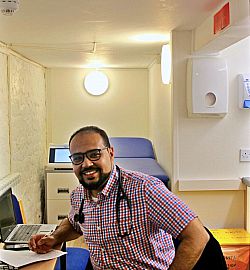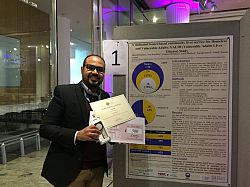Spotlight on Dr Ahmed Hashim
Hepatology Clinical Research Fellow at Brighton and Sussex Medical School
 Previous Research
Previous Research
I qualified as a medical doctor in Sudan in the Medical School of the University of Khartoum in 2008 and came to the UK. I started my postgraduate training and then moved to London for my core medical training. I worked in the institute of liver diseases at King’s College Hospital before I applied for my gastroenterology and hepatology training and then completed one year in Kingston Hospital and the 2nd year here in Brighton at the Royal Sussex County Hospital.
I've always been interested in research so I achieved my diploma in research methodology immediately after qualifying as a medical doctor. I first carried out field research on schistosomiasis, which is basically a parasitic infection that causes liver scarring. I then got to know Dr Sumita Verma, who is the consultant hepatologist at the university, and because of my interest in community work and screening for liver disease in individuals at risk, chose to work on a community hostel based liver service.
Current Research
I am currently working on a dedicated hostel-based liver service for homeless and vulnerable people; the Vulnerable Adults Liver Disease (VALID) study. We are researching the prevalence of liver fibrosis (liver scarring) in this group. We use non-invasive testing to facilitate their engagement with the service. We are also looking at what predicts liver damage from a clinical point of view and the mechanisms of aggressive scarring through lab tests.
Brighton has one of the highest homelessness rates nationally. Last year, the rate of rough sleeping in the city reached a record high. Our main aim is to screen homeless people but we see any vulnerable individuals that are identified by the general practitioners. I would say around 60-70% of the cohort are people who are either homeless or living in unstable housing arrangements.
I believe that if you can prevent diseases in the community then you can relieve the burden on the hospitals. I would like to emphasize the need for community-based services in order to pick up diseases in an early setting, thereby, allowing for timely and effective interventions.
What excites me about this research is doing something for individuals who may otherwise not receive any help. I am also looking at the question as to why some people with the same risk factors, and perhaps same liver insult, develop more aggressive fibrosis than others, through the assessment of peripheral levels of T-Helper cell 17 cytokines. Together with our colleagues in Nottingham (Prof. Guru Aithal’s team), we will be investigating the role of micro RNAs and senescence markers in the process of liver scarring in relation to age. We also hope to be able to look at the accuracy of novel fibrosis biomarkers which are being developed from acellular matrix at the Royal Free Hospital.
The main challenge is engaging homeless and vulnerable people. Recruiting them to the clinic is one obstacle, and then the follow-up itself is another. We are discouraged from inviting participants ourselves because of ethical constraints so we rely on the hostel managers. The hostel workers have been really helpful and contributed significantly to the success of this model by distributing the adverts and getting patients booked in to my clinic, as well as helping with the follow-up and so on.
The cohort that I am recruiting and taking samples from have a high prevalence of hepatitis C (approximately one third). Out of 113 people screened, which is higher than most people would expect in such a difficult to engage group, we found 27% have got significant liver damage, and 18% with advanced damage. That is a considerably high prevalence. Most of these individuals are just walking around with this damage, because liver damage could be asymptomatic, completely painless until it becomes too advanced or until complications set in.
There is a 92% success rate and compliance with Hepatitis C treatment, and a 98% acceptance of the service. From those who turned up only one or two refused the service. Why is this model successful? Very importantly, through the successful involvement of stakeholders such as hostel managers, needle exchange services and general practitioners (namely Dr Tim Worthley). Secondly the use of a single point of care screening. They may have to come back for treatment, but in that particular hostel-based clinic room we have all the necessary tools to perform liver screening in one consultation. We have a liver scanner (FibroScan) that gives you the results immediately, blood sampling equipment, and I provide assessment and counselling for alcohol and substance misuse. Essentially everything is provided in one appointment and that's it.
 We have received a lot of recognition and commendation for running this healthcare model. We achieved finalist status at the Sustainable Healthcare Awards 2016, organised by the King's Fund. I was also shortlisted for the patient centred care category of the Royal College of Physicians awards 2017 and have been chosen to deliver the RCP Quincentennial lecture for the London and South East region highlighting the success of the VALID study. Our work was also commended by the British Association for the Study of the Liver, twice in 2016 and 2017, and received a prize from the Royal Society of Medicine last year.
We have received a lot of recognition and commendation for running this healthcare model. We achieved finalist status at the Sustainable Healthcare Awards 2016, organised by the King's Fund. I was also shortlisted for the patient centred care category of the Royal College of Physicians awards 2017 and have been chosen to deliver the RCP Quincentennial lecture for the London and South East region highlighting the success of the VALID study. Our work was also commended by the British Association for the Study of the Liver, twice in 2016 and 2017, and received a prize from the Royal Society of Medicine last year.
The Future
We would like to run a national study using the same strategy and we will be holding a preceptorship workshop to talk about our model and explore how providing a near patient with non-invasive tests can be replicated at a national level. Brighton has a high prevalence of homelessness but there are bigger cities, so if we do this in other cities then we can help more people with hepatitis-C. We can treat them and have more understanding about the mechanisms of fibrosis.
I have been approached by colleagues in Sudan to set up the first community-based liver service for people at high risk in the suburbs of Khartoum. We have almost finalised the proposal for that, and my next step would be to have a more global understanding of how these community liver services should be designed, which will in turn allow me to compare the different mechanisms and predictors of liver damage and further evaluate the impact of ethnic and geographical factors on the process of liver scarring.
Interview by Alex Aghajanian

